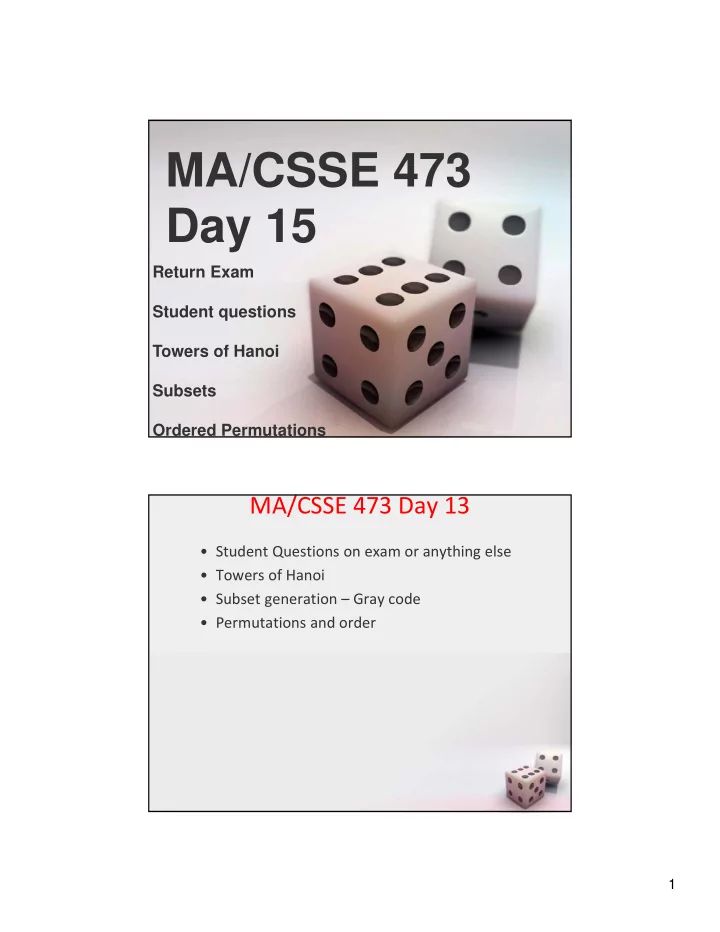

MA/CSSE 473 Day 15 Return Exam Student questions Towers of Hanoi Subsets Ordered Permutations MA/CSSE 473 Day 13 • Student Questions on exam or anything else • Towers of Hanoi • Subset generation – Gray code • Permutations and order 1
Towers of Hanoi • Move all disks from peg A to peg B • One at a time • Never place larger disk on top of a smaller disk • Demo • Code • Recurrence and solution Towers of Hanoi code Recurrence for number of moves, and its solution? 2
Permutations and order • Given a permutation number permutation number permutation 0 0123 12 2013 of 0, 1, …, n ‐ 1, can 1 0132 13 2031 we directly find the 2 0213 14 2103 next permutation in 3 0231 15 2130 the lexicographic 4 0312 16 2301 sequence? 5 0321 17 2310 6 1023 18 3012 • Given a permutation 7 1032 19 3021 of 0..n ‐ 1, can we 8 1203 20 3102 determine its 9 1230 21 3120 10 1302 22 3201 permutation 11 1320 23 3210 sequence number? • Given n and i, can we directly generate the i th permutation of 0, …, n ‐ 1? Subset generation • Goal: generate all subsets of {0, 1, 2, …, N ‐ 1} • Bottom ‐ up (decrease ‐ by ‐ one) approach •First generate S n ‐ 1 , the collection of all subsets of {0, …, N ‐ 2} • Then S n = S n ‐ 1 { S n ‐ 1 {n ‐ 1} : s S n ‐ 1 } 3
Subset generation • Numeric approach: Each subset of {0, …, N ‐ 1} corresponds to an bit string of length N where the i th bit is 1 iff i is in the subset. • So each subset can be represented by N bits. • A simple loop generates them all in "numeric" order. Subset generation • Minimal change algorithm : • flip exactly one bit each time we generate the next subset. • Most common minimal ‐ change approach: Binary ‐ reflected Gray code. See the links in the announcements page and the schedule page. • Transition sequences: which bit to flip • 0 010 0102010 010201030102010 4
Recap: Permutations and Order • Given a permutation number permutation number permutation 0 0123 12 2013 of 0, 1, …, n ‐ 1, can 1 0132 13 2031 we directly find the 2 0213 14 2103 next permutation in 3 0231 15 2130 the lexicographic 4 0312 16 2301 sequence? 5 0321 17 2310 6 1023 18 3012 • Given a permutation 7 1032 19 3021 of 0..n ‐ 1, can we 8 1203 20 3102 determine its 9 1230 21 3120 10 1302 22 3201 permutation 11 1320 23 3210 sequence number? • Given n and i, can we directly generate the i th permutation of 0, …, n ‐ 1? Discovery time (with two partners) • Which permutation follows each of these in lexicographic order? – 183647520 471638520 – Try to write an algorithm for generating the next permutation, with only the current permutation as input. • If the lexicographic permutations of the numbers [0, 1, 2, 3, 4, 5] are numbered starting with 0, what is the number of the permutation 14032? – General form? How to calculate efficiency? • In the lexicographic ordering of permutations of [0, 1, 2, 3, 4, 5], which permutation is number 541? – How to calculate efficiently? 5
Recommend
More recommend